La Sportiva Jackal GTX
Test Locations: Gunnison — Crested Butte & Grand Junction, Colorado
Test Duration: 65 miles
Stated Stack Height: 29 mm (heel) / 22 mm (forefoot)
Stated Heel-to-Toe Drop: 7 mm
Stated Features:
- Gore-Tex Invisible Fit waterproof / breathable upper
- FriXion 2.0 outsole compound
- Near seamless upper with reinforced lace eyelets
- High-volume fit and, wider forefoot
- Infinite PU inserts for extra cushioning
Reviewer: 6’2″, 160 lbs / 188 cm, 70 kg
Size Tested: US Men’s 11.5
Stated Weight per Shoe (US Men’s Size 9): 315 g / 11.1 oz
Blister Measured Weight (US Men’s 11.5):
- Shoes + Laces: 343 g (left) & 342 g (right)
- Insoles: 21 g (left) & 20 g (right)
- Total: 364 g (left) & 362 g (right)
MSRP: $170
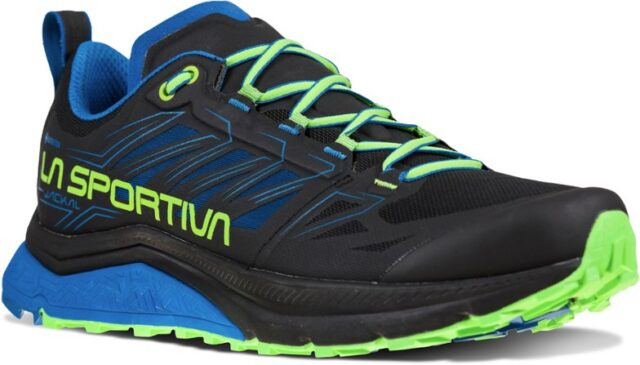
Intro
Gore-Tex and waterproof running shoes are, in my opinion, a pretty niche thing. I’ve always operated under the mantra that if you don’t want to get your feet wet, then don’t go running on trails. You typically either get wet feet from running through puddles, dewy grass, etc. with a non-waterproof shoe, or you get wet from the borderline unavoidable sweat created by running in a waterproof shoe.
Winter, however, is a totally different animal. As someone who isn’t interested in road running, I thought that a Gore-Tex shoe would be a good way to stay off the pavement while maintaining a running routine in the winter months.
La Sportiva offers a variety of Gore-Tex and waterproof running shoes in their lineup. Of those shoes, the Jackal GTX is designed to be a “higher volume” shoe with extra cushioning geared toward longer distance runs — much like the standard, non-waterproof version of the Jackal (check out our full review of the Jackal here). That all sounds great to me, but my main question going into this experiment was: will the Jackal GTX feel like other “normal” running shoes, or will it be sweaty, clunky, and generally less “normal” with the addition of the Gore-Tex material?
Overall, I would say that the Jackal GTX is a solid choice for someone looking for a waterproof running shoe that will keep their feet drier and warmer in the winter. That being said, after 65 miles in the shoe, I have a few thoughts that might help you determine whether or not the Jackal GTX is the right shoe for you.
Fit
Like any running shoe, the only way to really know how the Jackal GTX is going to fit your feet is to go into a store and try it on. That being said, here is my experience with how they fit my fairly average-width, average-volume feet.
La Sportiva’s shoes generally run a half- to a full-size smaller than other shoe companies. In Altra and Hoka shoes, I have traditionally worn a US men’s 10-10.5. Because I would be using the Jackal GTX primarily in winter, I wanted to allow plenty of room for thicker socks, so I went with a men’s 11.5.
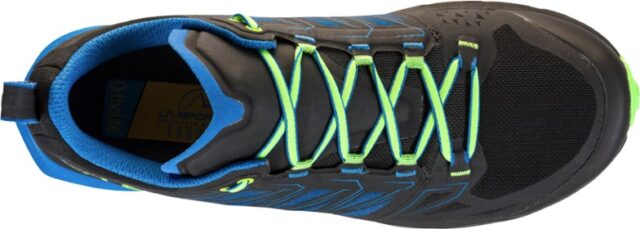
I would say that the “higher volume” aspect of the La Sportiva Jackal GTX is as advertised. The 11.5 size allows me to wear multiple pairs of socks on cold days. The laces are made out of a material that has a tiny bit of stretch to it, but when I cinch the laces down tight, they hold that tightness really well. That tightness allows my foot to feel secure within the shoe, even if my toes are “swimming” a little bit. Indeed, one of the stated features is a “wider forefoot.” While the volume of the Jackal GTX’s toe box isn’t quite on par with the width I’d expect from, say, an Altra running shoe, the Jackal GTX’s wider forefoot does allow my toes to expand while running.
I think if I was going to get another pair, I would likely get the Jackal GTX in a size 11. The 11.5 was just a little longer and roomier than I needed it to be. If you’re using the Jackal GTX in a primarily wet (and not necessarily super cold) environment, such as the Pacific Northwest, you might consider going a little smaller as well since you probably won’t be layering up your feet with thick socks.
Weight
With a stated weight of 11.1 oz / 315 grams for a US men’s 9, the La Sportiva Jackal GTX is by no means a minimalist or super lightweight shoe. However, the Jackal GTX is not all that much heavier than its non-Gore-Tex counterpart, the standard Jackal — the Gore-Tex upper only reportedly adds .6 oz / 15 grams per shoe. Compared to other waterproof shoes on the market with similar stack heights and heel-to-toe drops, I would say that the Jackal GTX is around the middle of the pack, or perhaps on the lighter side of what could be considered a generally heavier category of shoes. As a reference, here is a list of some other similar Gore-Tex and waterproof running shoes on the market (all stated weights are based on a US Men’s Size 9):
270 g / 9.5 oz – La Sportiva Kaptiva GTX
280 g / 10 oz – Merrell Nova 2 Gore-Tex
290 g / 10.23 oz – Salomon Wildcross GTX
309 g / 10.9 oz – Hoka One One Challenger ATR 6 Gore-Tex
315 g / 11.1 oz – La Sportiva Jackal GTX
337 g / 11.9 oz – Salomon Speedcross 5 GTX
346 g / 12.2 oz – Hoka One One Speedgoat 4 GTX
374 g / 13.2 oz – Altra Lone Peak ALL-WTHR Low
400 g / 14.15 oz – La Sportiva Wildcat 2 GTX
Most of the shoes on this list have comparable stack heights and heel-to-toe drops, with a couple of exceptions. The Kaptiva GTX and Wildcat 2 GTX are definitely the most obvious outliers. The Kaptiva has a more minimal midsole, with a stated stack height of 17 mm in the heel that drops to 11 mm in the forefoot, while the Wildcat 2 GTX is by far the heaviest. I included them on the list just to give an idea of the variety of waterproof shoes on the market, particularly in the La Sportiva lineup. The best comparisons to the Jackal GTX would probably be the Merrell Nova 2 Gore-Tex and the Salomon Wildcross GTX. Both have nearly identical stated stack heights and heel-to-toe drops as the La Sportiva Jackal GTX, though they also both shave off about an ounce per shoe compared to the Jackal GTX.
I will say that once I got used to running in the La Sportiva Jackal GTX, the shoes have not felt excessively heavy on my feet. If you are used to running in a truly minimalist shoe, such as the Altra Superior or perhaps La Sportiva’s VK BOA, the Jackal GTX will probably feel noticeably heavier — but those are also both a very different style of running shoe than the Jackal GTX, so they aren’t really a fair comparison.
Upper
The La Sportiva Jackal GTX has a “near seamless” upper lined with a Gore-Tex Invisible Fit waterproof / breathable membrane. As I alluded to above, this winter has been my first foray into Gore-Tex running shoes and the Jackal GTX’s upper is definitely a lot burlier than the more minimalist shoes I have grown accustomed to — shoes like the Altra Superior, which is my usual go-to shoe, have much lighter mesh uppers. That’s not too surprising, but even compared to a fairly similar Gore-Tex shoe like the Hoka Challenger ATR 6 GTX, the Jackal’s upper gives your feet much more of a feeling of separation / protection from the elements. The Jackal GTX’s harder TPU toecap also adds an extra layer of protection to the front of the shoe.
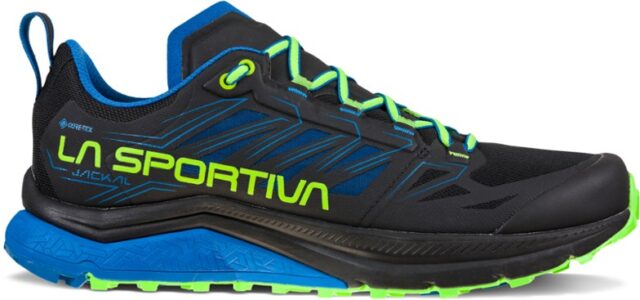
Thus far I have not experienced any blistering or hotspots while running in the Jackal GTX. The waterproofing quality seems to be as advertised, though I have used the Jackal GTX primarily in snow and have not been able to take them out in excessively wet or muddy conditions — I’ll report back once I’ve had a chance to do that this Spring. In winter conditions, the Gore-Tex membrane (along with a thicker sock) has definitely kept my feet warm, even in the sub-zero temperatures we get here in the Gunnison Valley. That’s great in the winter, but it’s also an indication that the Jackal GTX does not offer great breathability. When most folks think about breathability, or lack thereof, they usually think about sweaty feet. In terms of winter running, especially in extreme cold temperatures, less breathability translates to warmer feet because the Gore-Tex membrane traps in heat and moisture. Wool socks take care of any moisture issues in the winter, but I imagine that if you were to use the Jackal GTX in a warmer climate, you would likely end up with hot, sweaty feet. I’ll report back if / when I’m able to use the Jackal GTX in warmer weather.
Midsole
La Sportiva’s Jackal GTX offers a pretty stiff-flexing midsole with ample cushion, ideal for longer runs. The stated stack height is 29 mm in the heel and 22 mm in the toe. A built-in rock guard protects the feet from various protrusions — which is great, but I also think it gives the Jackal GTX a pretty stiff feel. I’m a big fan of shoes with removable rock guards (e.g. the Altra Superior 4.5), which, in my opinion, make a shoe much more versatile. That said, the structure of the Jackal GTX’s midsole, including the built-in rock plate, provides a reassuring amount of protection for my feet, much more so than the aforementioned Altra Superior 4.5. The cushion of the Jackal GTX felt stiff at first, but after a few runs, I have no lingering complaints and they are very comfortable to run in.
Outsole
The bulk of the Jackal GTX’s outsole consists of a fairly hard rubber compound, with a minimal amount of hard foam exposed below the arch and parts of the heel. The lug spacing on the Jackal GTX is a little wider than shoes like the Altra Olympus 4.0 and Hoka Challenger 6.
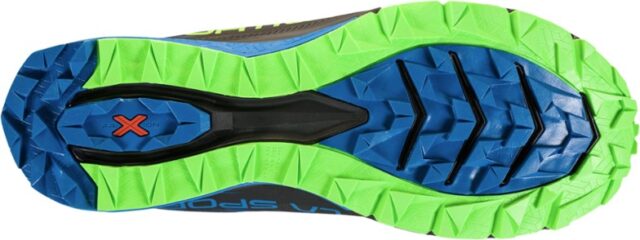
In my experience, the Jackal GTX’s tread pattern works great for the packed snow and smoother singletrack that I have used it on. The rubber of the tread does feel harder than the outsoles on the Altra Superior 4.0 or Hoka Challenger 6 GTX. That’ll probably make it more durable, but it also makes the Jackal GTX feel a little insecure on rocks — and downright slippery on wet rock. It does seem like the harder outsole compound will last over many miles — running shoe outsoles generally have to make a tradeoff between grip and durability, and, at least in my opinion, the Jackal GTX’s outsole definitely errs on the side of durability.
On the Trail
I’ll admit, I was slow to warm up to the La Sportiva Jackal GTX. But once I did get used to it, I’ve actually really enjoyed it for running on snow-covered singletrack and gravel roads.
It took a solid 30 miles to break in the Jackal GTX. My first impression was that it felt unbelievably stiff. The midsole seemed as hard as a board, and it felt like there was no flex at all in the shoe on my first couple of runs. As someone who’s used to the soft cushion and easy flex that you find with shoes like the Altra Superior 4.0, I wasn’t sure I was going to enjoy my first experience with La Sportiva’s running shoes. Perseverance, however, yields many fruits.
That hard cushion softened and perhaps formed to the bottom of my foot after the first 30-ish miles of use. I’m not sure if Jackal GTX’s flexibility increased as well or if I just got used to it — whatever the case, by mile 50, I had begun to look forward to running in the Jackal GTX.
I have noticed that the Jackal GTX changes my stride slightly, and not necessarily in a way that I personally prefer. I’m a pretty firm believer in the forefoot strike, and usually run up on the balls of my feet. However, after a couple weeks of running in the Jackal GTX, I realized that I had reverted back to landing either on my heel or the middle of my foot. I wasn’t overly surprised, since the Jackal has a higher (7 mm) stated heel-to-toe drop than my usual 0-4mm-drop shoes. Heel / midfoot striking definitely isn’t my preferred style, but it actually hasn’t been as big of a problem as I’d expected it to be with the Jackal GTX. The shoe’s construction definitely makes a heel / midfoot strike feel a bit more natural, and it hasn’t caused any issues for me so far.
Before I mention anything about dexterity and running on technical trails with lots of rock, I will put out the caveat that 80% of the running I’ve done in the Jackal GTX has been on packed snow. That being said, when I did take them for a spin on dry trails with rocks, I found them to feel a little clumsy — especially compared to the more minimal shoes that I’m used to running in, such as various iterations of the Altra Superior. The Jackal GTX’s stiff midsole definitely played a role in its less-than-nimble feel — I found that the entire shoe would tilt one way or another with undulations in the trail (rather than conforming to them), forcing my ankle to absorb almost all of the shock. I’ll be curious to see if that changes as the shoes continue to break in.
Whatever the case, thus far I have found that when the going gets rough, the Jackal GTX feels clunky and unstable to me — not due to the addition of Gore-Tex material, but, in my opinion, because of the shoe’s midsole and outsole. As mentioned above, I also found the grip of the outsole to be lacking, especially when any moisture is involved — which doesn’t really help on technical terrain.
I’ll note here that this was my personal experience with the Jackal GTX, which could be influenced by a couple of factors. One, I sized up to accommodate for thicker socks. If I had sized down for a snugger fit, it is possible that the Jackal GTX would feel more nimble and / or stable. I would encourage anyone considering the Jackal GTX to size appropriately for the climate you will be running in (e.g., whether you really need extra room for thick socks) and adjust your expectations accordingly. Another thing is that I have traditionally stuck to more minimalist shoes such as the Altra Superior 4.5. Going from a true minimalist running shoe with zero drop to something like the Jackal GTX that has a more substantial midsole with a built-in rock guard and higher heel-to-toe drop is always going to require an adjustment in style.
One thing about the Jackal GTX that is true to the description is that they did seem ideal for longer runs. Whether my feet were drastically more or less tired after a longer run than other shoes, I can’t yet say. But I have taken the Jackal GTX on a few 2+ hour runs and I have yet to develop any blisters, cramps, or other noteworthy foot / leg fatigue. It’s not an ultra-plush ride, but it’s comfortable enough for my preferences.
Durability
Just picking up the Jackal GTX, I thought it felt like a pretty bomber shoe, and after 65 miles in them, that initial reaction has held true so far. Aside from breaking in a bit after 30-50 miles, the midsole doesn’t feel overly worn down or compacted. The upper shows no signs of wear whatsoever. The outsole is just starting to show a little wear near the toe, but that is negligible compared to the overall state of the tread, which looks almost new.
The caveats to this are that I have done most my running in the Jackal GTX on packed snow, so I would not expect it to show much wear, and I’ve only put 65 miles in them so far. That being said, I fully expect the Jackal GTX to last well into the hundreds of miles. I’ll post a longer-term update as I accumulate more miles in the shoe.
Who’s It For?
The La Sportiva Jackal GTX is worth a look for folks looking for a winter running shoe and who do most of that running on fairly smooth, non-technical terrain. The Jackal GTX would also be a decent option for folks in less cold but very wet climates who want to keep their feet drier than they’d be in a non-waterproof shoe. The one thing I would say is that if you are running on trails with wet roots or rocks, personally, I would want a shoe that’s a bit more flexible and that has a stickier, more aggressive outsole. And those seeking a super plush / soft or very minimal shoe should look elsewhere. But for winter running on snowy trails and roads in Colorado, the Jackal GTX has ended up working quite well for me. It’s not as winter-specific as something like the La Sportiva Blizzard GTX, and consequently doesn’t feel as secure on icy sections, but the Jackal GTX is also a much less niche / more versatile shoe than a lot of winter-specific options like the Blizzard.
One downside to the Jackal GTX is the price tag. At $170 retail, it’s definitely on the upper end of the price spectrum for running shoes. You are always going to pay more for Gore-Tex — that’s just a fact of life. And you could find some less expensive alternatives that use a proprietary / non-Gore-Tex waterproof membrane. But at least from my perspective, the Jackal GTX’s construction feels up to par with its high price, and that price isn’t out of the ordinary for a Gore-Tex shoe.
Bottom Line
If you’re looking for a fairly stiff running shoe with plenty of cushion and that will keep your feet warmer and drier in cold, wet conditions, La Sportiva’s Jackal GTX could be worth a try. Though I was slow to warm up to it, the Jackal GTX has become my go-to running shoe this winter. It’s kept my feet comfortable on snow-packed trails, both in terms of keeping them warm and dry, and in terms of minimizing foot fatigue. If you are doing most of your running in cold and/or wet environments on less technical trails and dirt roads (perhaps covered in snow), the Jackal GTX is certainly worth considering.

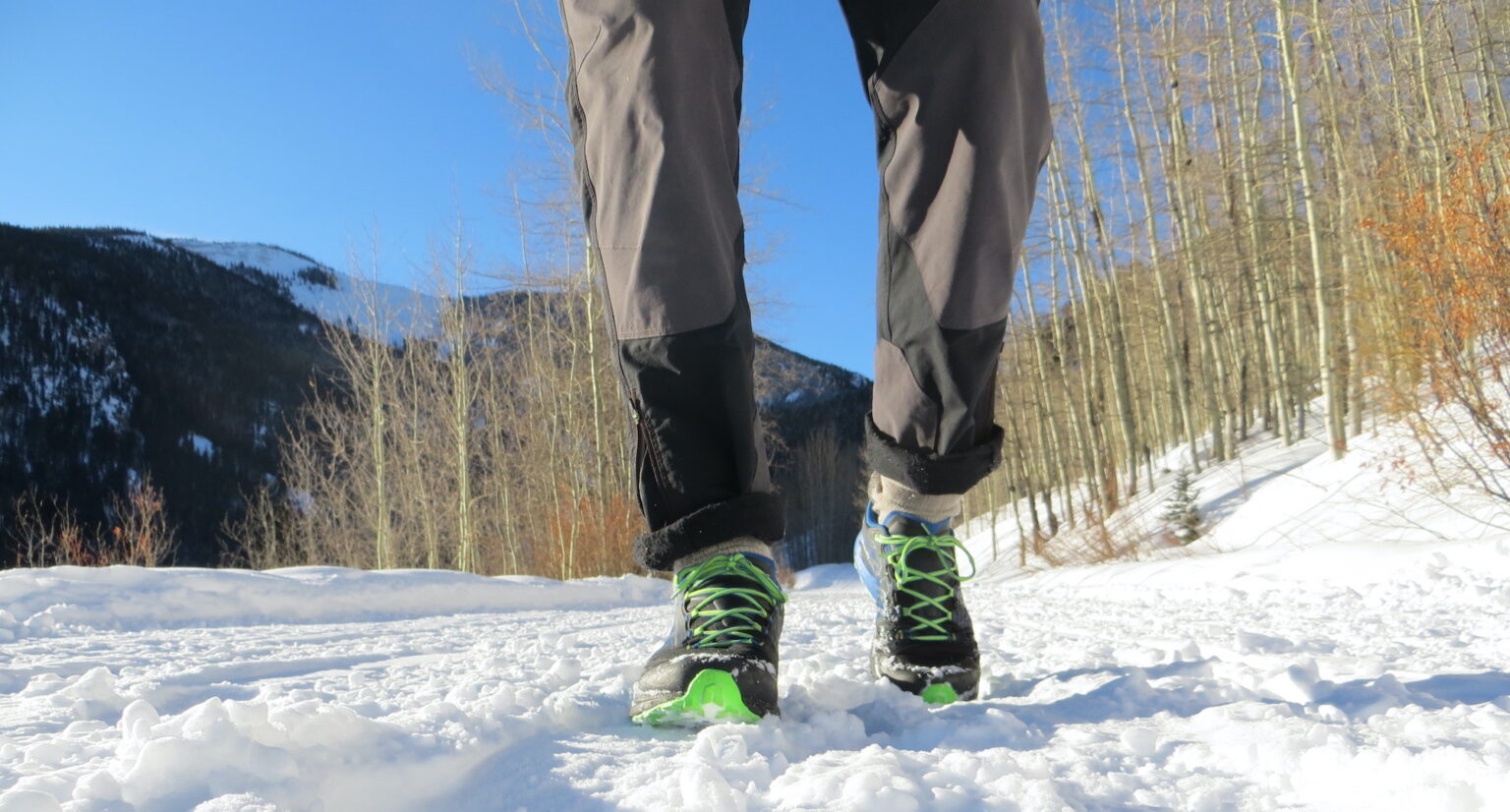

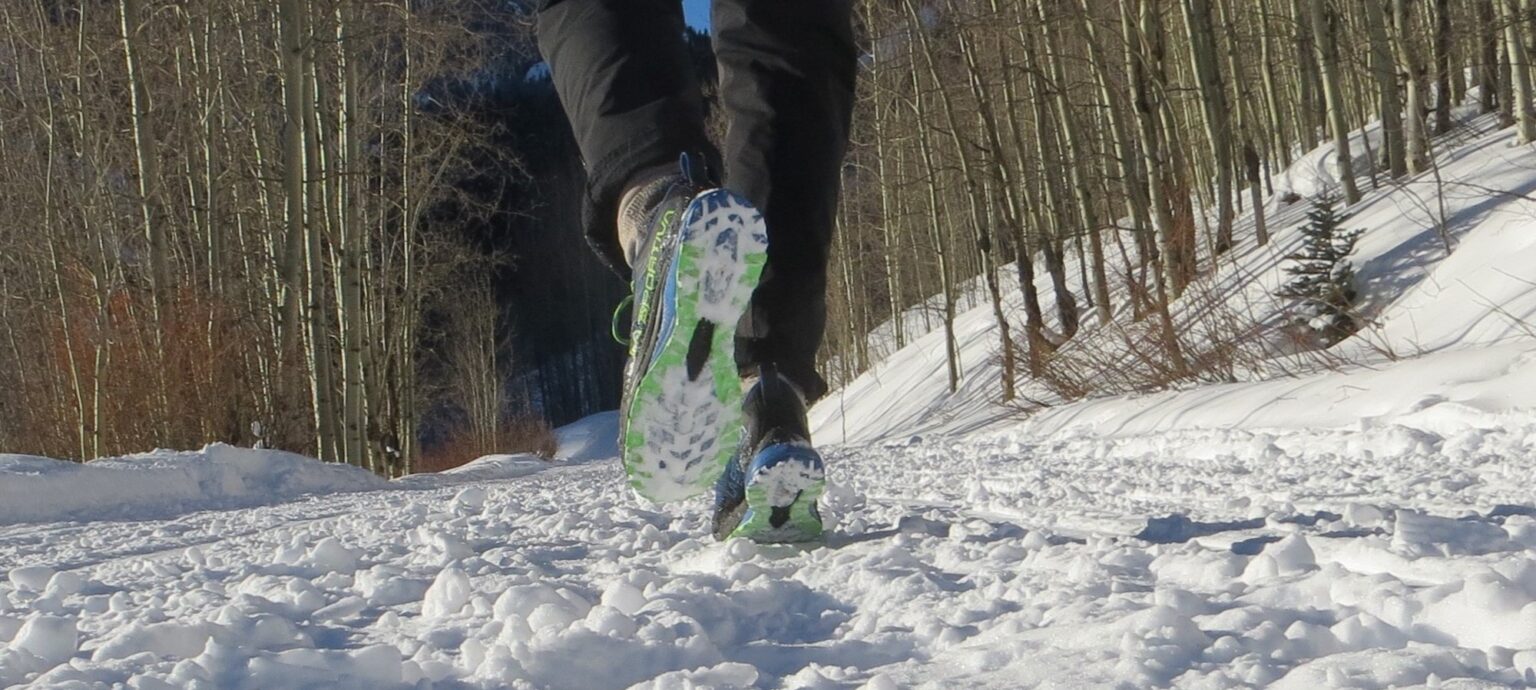
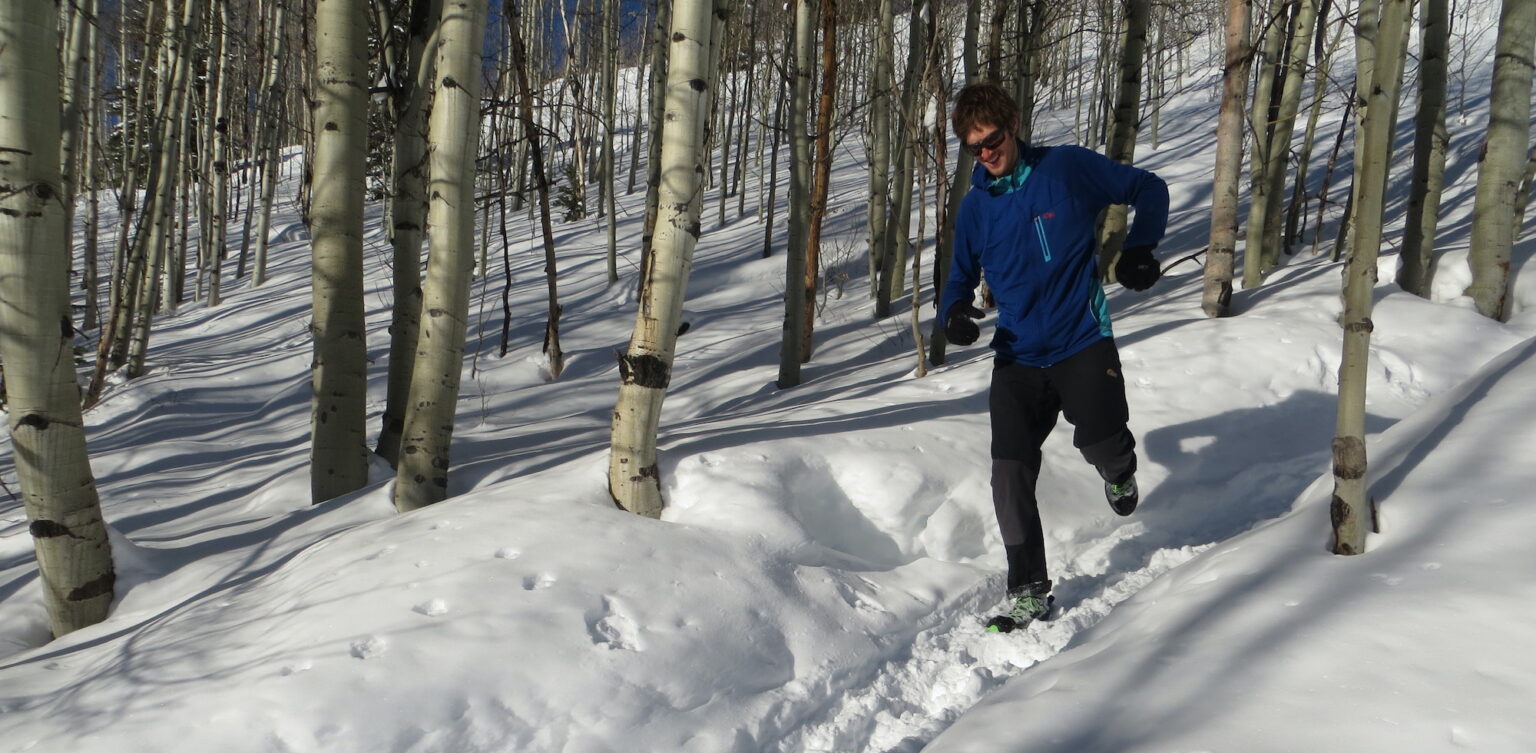
The question is, is the sole sticky enough so the Jackal can be used as a summer hiking shoe?
I’m not sure I would describe the sole as sticky (or maybe not tacky would be a better way to put it), at least not in the way that vibram or other materials like that are. Personally, if there is a lot of rock involved, such as a ridge scramble, I don’t think the Jackal GTX would be my first choice, but I do think it would work great for hiking on dirt trails. Hope that answers your question.